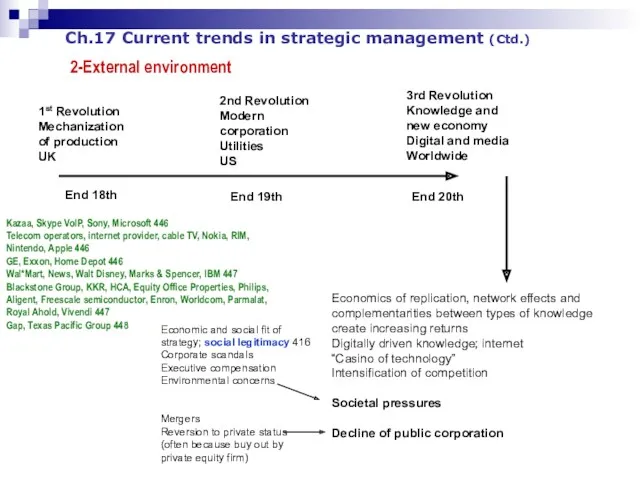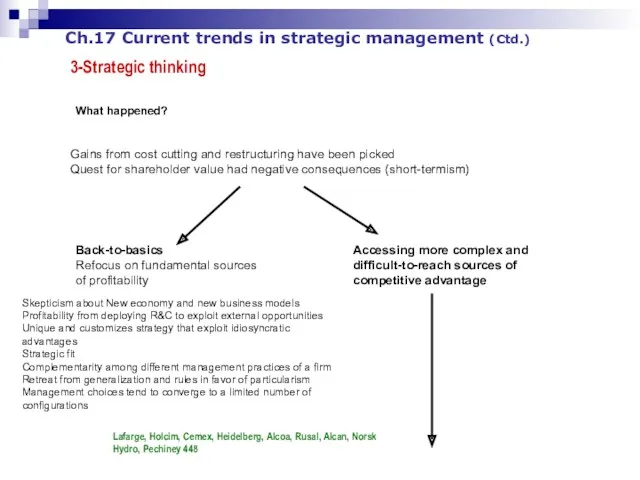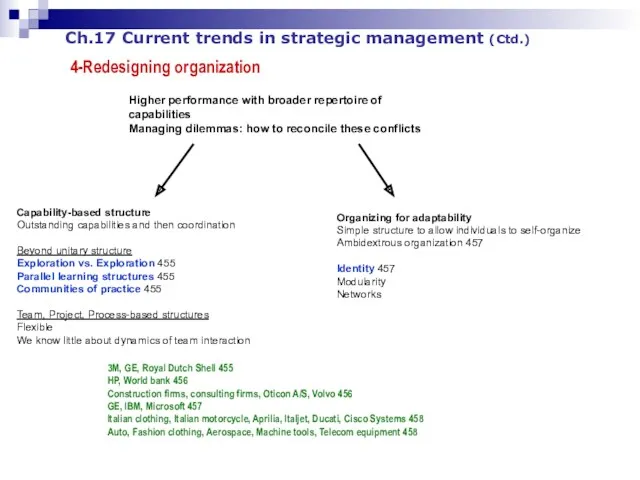Содержание
- 2. Ch.01 The concept of strategy 2
- 3. Ch.1 Concept of Strategy 3 Four characteristics of three successful « strategic behaviors and outcomes »
- 4. 4 Ch.1 Concept of Strategy (Ctd.) Strategy (14, 17) Strategic principles (25) Corporate strategy (19) Busines
- 5. Ch.1 Concept of Strategy (Ctd.) 5 Realized strategy Environment Deliberate strategy Emergent strategy Roles of strategy
- 6. Ch.02 Goals, values and performance 6
- 7. 7 Ch.2 Goals, values and performance Value (for customers and profit) (p35) Value-added (p35) Profit (p37-38)
- 8. 8 Ch.2 Goals, values and performance To avoid ethical and societal issues, simplifying assumption: Goal =
- 9. 9 Ch.2 Goals, values and performance (Ctd.) Real options In a world of uncertainty, flexibility is
- 10. 10 Ch.2 Goals, values and performance (Ctd.) Past Present Future Backward-looking performance DCF function of 3
- 11. Values and Principles Pursuit of profit constrained by values and principles -Values as external image management
- 12. Ch.03 Industry analysis: the fundamentals 12
- 13. 13 Ch.3 Industry analysis: the fundamentals Profit Sources of profit? CL-S Which industry ? How to
- 14. 14 Ch.3 Industry analysis: the fundamentals (Ctd.) Industry P5F General Environment PEST
- 15. 15 Ch.3 Industry analysis: the fundamentals (Ctd.) Value = price that customer is willing to pay
- 16. 16 Ch.3 Industry analysis: the fundamentals (Ctd.) BPS Cost/total cost P Differentiation Competition between S Size
- 17. 17 Ch.3 Industry analysis: the fundamentals (Ctd.) Description of industry Structure Complex value-chain and vertical integration
- 18. 18 Ch.3 Industry analysis: the fundamentals (Ctd.) Key Success Factors Question approach 1-What do customers want?
- 19. 19 Ch.3 Industry analysis: the fundamentals (Ctd.) Consumer surplus (p67) Producer surplus (economic rent) (p67) Monopoly
- 20. Ch.04 Further topics in industry and competitive analysis 20
- 21. 21 Ch.4 Industry and competitive analysis: further 1-What about « complementary » relationship between products? 2-Stability
- 22. 22 Ch.4 Industry and competitive analysis: further (Ctd.) 1-What about « complementary » relationship between products?
- 23. 23 Ch.4 Industry and competitive analysis: further (Ctd.) 2-Stability of industry Which direction? Industry Competition Creative
- 24. 24 Ch.4 Industry and competitive analysis: further (Ctd.) Necessity to take into account interaction among players
- 25. 25 Ch.4 Industry and competitive analysis: further (Ctd.) 4-Competitor analysis Competitor intelligence (p.107) 1-Forecast 2-Predict 3-Influence
- 26. 26 Ch.4 Industry and competitive analysis: further (Ctd.) 5-Level of analysis: Segmentation of industry Segmentation (p.110)
- 27. Ch.05 Analyzing Resources and Capabilities 27
- 28. 28 Ch.5 Analyzing Resources and Capabilities 1-R&C and strategy 2-R&C: nature and attributes 3-Appraising R&C 4-R&C
- 29. 29 Ch.5 Analyzing Resources and Capabilities (Ctd.) 1-R&C and strategy Firm Goals; R&C; structure and systems
- 30. 30 Ch.5 Analyzing Resources and Capabilities (Ctd.) 2-R&C: Nature and attributes Resource = productive asset owned
- 31. 31 Ch.5 Analyzing Resources and Capabilities (Ctd.) 2-R&C: Nature and attributes Capability = what the firm
- 32. 32 Ch.5 Analyzing Resources and Capabilities (Ctd.) 2-R&C: Nature and attributes Organizational routine = regular and
- 33. 33 Ch.5 Analyzing Resources and Capabilities (Ctd.) 3-Appraising R&C What is the potential of R&C to
- 34. 34 Ch.5 Analyzing Resources and Capabilities (Ctd.) 4-R&C Management R&CM: a framework A practical guide to
- 35. 35 Ch.5 Analyzing Resources and Capabilities (Ctd.) 5-Developing capabilities Relationship between R and C We know
- 36. 36 Ch.5 Analyzing Resources and Capabilities (Ctd.) 6-KM and KBV Know-how 160 Knowing about 160 Knowledge
- 37. 37 Ch.5 Analyzing Resources and Capabilities (Ctd.) 6-KM and KBV Saatchi & Saatchi 159 Coca-cola 160
- 38. Ch.06 Organization structure and management systems 38
- 39. 39 Ch.6 Organization structure and management systems 1-Evolution of structure 2-Organizational problem: Specialization with Coordination 3-Hierarchy
- 40. 40 1-Evolution of structure Ch.6 Organization structure and management systems (Ctd.) Ancient form Networks of self-employed,
- 41. 41 2-Organizational problem: Specialization with Coordination Ch.6 Organization structure and management systems (Ctd.) Structure = ways
- 42. 42 3-Hierarchy Ch.6 Organization structure and management systems (Ctd.) Hierarchy = system composed of interrelated sub-systems
- 43. 43 4-Application of organizational structure design principles Ch.6 Organization structure and management systems (Ctd.) Basic design
- 44. 44 5-Alternative structural forms Ch.6 Organization structure and management systems (Ctd.) Functional F 186-187 Functional lines
- 45. 45 6-Management systems Ch.6 Organization structure and management systems (Ctd.) 1-Information systems 2-Strategic planning systems Vehicle
- 46. Ch.07 The nature and source of competitive advantage 46
- 47. 47 Ch.7 Nature and source of competitive advantage 1-Emergence of competitive advantage 2-Sustaining competitive advantage 3-Competitive
- 48. 48 1-Emergence of competitive advantage Ch.7 Nature and source of competitive advantage (Ctd.) 1-External sources of
- 49. 49 1-Emergence of competitive advantage Ch.7 Nature and source of competitive advantage (Ctd.) 1-External sources of
- 50. 50 2-Sustaining competitive advantage Ch.7 Nature and source of competitive advantage (Ctd.) Once established, competitive advantage
- 51. 51 3-Competitive advantage in different market settings Ch.7 Nature and source of competitive advantage (Ctd.) For
- 52. 52 4-Types of competitive advantage: Cost and Differentitation Ch.7 Nature and source of competitive advantage (Ctd.)
- 53. Ch.08 Cost advantage 53
- 54. 54 Ch.8 Cost advantage 1-Strategy and cost advantage 2-Sources of cost advantage 3-Analysis of cost: value
- 55. 55 Ch.8 Cost advantage (Ctd.) 1-Strategy and cost advantage First preoccupation was cost Large corporations Search
- 56. 56 Ch.8 Cost advantage (Ctd.) 2-Sources of competitive advantage Cost drivers 227 Variations Position firm /
- 57. 57 Ch.8 Cost advantage (Ctd.) 3-Analysis of cost: value chain Value chain disaggregation of firm’s activities
- 58. Ch.09 Differentiation advantage 58
- 59. 59 Ch.9 Differentiation advantage 1-Nature of Differentiation advantage 2-Analysis: Demand side 3-Analysis: Supply side 4-Analysis: Value
- 60. 60 Ch.9 Differentiation advantage (Ctd.) 0-Introduction Differentiation = providing something unique that is valuable to consumers
- 61. 61 Ch.9 Differentiation advantage (Ctd.) 1-Nature of Differentiation advantage Differentiation can exist in every aspect of
- 62. 62 Ch.9 Differentiation advantage (Ctd.) 2-Demand side Which product characteristics have potential to create value for
- 63. 63 Ch.9 Differentiation advantage (Ctd.) 3-Supply side Differentiation depends on firm’s ability to offer differentiation Drivers
- 64. 64 Ch.9 Differentiation advantage (Ctd.) 3-Supply side Differentiation effective only if communication to customers Search good
- 65. 65 Ch.9 Differentiation advantage (Ctd.) 4-Analysis: value chain Process: 1-Construct value chain 2-Identify drivers of uniqueness
- 66. Ch.10 Industry evolution and strategic change
- 67. Ch.10 Industry evolution and strategic change 1-Introduction 2-Industry life cycle 3-Structure, competition and success factors over
- 68. Ch.10 Industry evolution and strategic change (Ctd.) 1-Introduction Change is the “constant” Greatest challenge is match
- 69. Ch.10 Industry evolution and strategic change (Ctd.) 2-Industry life cycle Product life cycle 263 Industry life
- 70. Ch.10 Industry evolution and strategic change (Ctd.) 3-Structure, competition and success factors over life cycle Changes
- 71. Ch.10 Industry evolution and strategic change (Ctd.) 4-Organizational adaptation and change Evolutionary theory Variation Selection Retention
- 72. Ch.10 Industry evolution and strategic change (Ctd.) 4-Organizational adaptation and change Empirical evidence shows changes in
- 73. Ch.10 Industry evolution and strategic change (Ctd.) 4-Organizational adaptation and change Managing change Recognition by managers
- 74. Ch.10 Industry evolution and strategic change (Ctd.) 5-WRAP-UP Change is the “constant” Adaptation firm and environmental
- 75. Ch.11 Technology-based industries and the management of innovation
- 76. Ch.11 Technology-based industries and the management of innovation 1-Introduction 2-Competitive advantage in technology-intensive industries 3-Exploit innovation:
- 77. Ch.11 Technology-based industries and the management of innovation (Ctd.) 1-Introduction In industries where innovation is key,
- 78. Ch.11 Technology-based industries and the management of innovation (Ctd.) 2-Competitive advantage in technology-intensive industries Innovation process
- 79. Ch.11 Technology-based industries and the management of innovation (Ctd.) 2-Competitive advantage in technology-intensive industries Property rights
- 80. Ch.11 Technology-based industries and the management of innovation (Ctd.) 3-Exploit innovation: when and where to enter?
- 81. Ch.11 Technology-based industries and the management of innovation (Ctd.) 3-Exploit innovation: when and where to enter?
- 82. Ch.11 Technology-based industries and the management of innovation (Ctd.) 3-Exploit innovation: when and where to enter?
- 83. Ch.11 Technology-based industries and the management of innovation (Ctd.) 4-Competing for standards Linux, Microsoft, Qualcomm, automobile
- 84. Ch.11 Technology-based industries and the management of innovation (Ctd.) 4-Competing for standards Apple, IBM, Microsoft, Netscape,
- 85. Ch.11 Technology-based industries and the management of innovation (Ctd.) 5-Creating conditions for innovation Isaac Newton, James
- 86. Ch.11 Technology-based industries and the management of innovation (Ctd.) 5-Creating conditions for innovation US naval establishment
- 87. Ch.11 Technology-based industries and the management of innovation (Ctd.) 6-WRAP-UP Central concepts: Invention and innovation How
- 88. Ch.12 Competitive advantage in mature industries
- 89. Ch.12 Competitive advantages in mature industries 1-Introduction 2-Competitive advantage in mature industries 3-Strategy implementation in mature
- 90. Ch.12 Competitive advantages in mature industries (Ctd.) 1-Introduction McDonalds 320 Food, energy, construction, vehicles, financial services,
- 91. Ch.12 Competitive advantages in mature industries (Ctd.) 2-Competitive advantage in mature industries Capsule Media sector and
- 92. Ch.12 Competitive advantages in mature industries (Ctd.) 2-Competitive advantage in mature industries Actions Cost inefficiencies tend
- 93. Ch.12 Competitive advantages in mature industries (Ctd.) 2-Competitive advantage in mature industries Quest for differentiation Commoditization
- 94. Ch.12 Competitive advantages in mature industries (Ctd.) 2-Competitive advantage in mature industries Rejuvenation and Managerial and
- 95. Ch.12 Competitive advantages in mature industries (Ctd.) 3-Strategy implementation in mature industries: structure, systems, style Reconcile
- 96. Ch.12 Competitive advantages in mature industries (Ctd.) 4-Strategies for declining industries Declining industry because: -technological substitution
- 97. Ch.12 Competitive advantages in mature industries (Ctd.) 5- Wrap-up Declining industries are characterized by classic features
- 98. Ch.13 Vertical Integration and the scope of the firm
- 99. Ch.13 Vertical integration and scope of firm 1-Introduction and goals 2-Scope of firm and transaction costs
- 100. Ch.13 Vertical integration and scope of firm (Ctd.) 1-Introduction and goals Product Scope Geographical Scope Vertical
- 101. Ch.13 Vertical integration and scope of firm (Ctd.) 2-Scope of firm and transaction costs Firm exists
- 102. Ch.13 Vertical integration and scope of firm (Ctd.) 3-Costs and benefits of VI Vertical integration VI
- 103. Ch.13 Vertical integration and scope of firm (Ctd.) 3-Costs and benefits of VI Technical economies from
- 104. Ch.13 Vertical integration and scope of firm (Ctd.) 3-Costs and benefits of VI Differences in optimal
- 105. Ch.13 Vertical integration and scope of firm (Ctd.) 3-Costs and benefits of VI Federal Express 348
- 106. Ch.13 Vertical integration and scope of firm (Ctd.) 4-Designing VI - Commitment + + Formalization -
- 107. Ch.13 Vertical integration and scope of firm (Ctd.) 4-Designing VI IT outsourcing 355 McDonalds, Century 21,
- 108. Ch.14 Global strategies and the Multinational Corporation
- 109. Ch.14 Global strategies and the Mutinational Corporation 1-Introduction and goals 2-Implication of international competition for industry
- 110. Ch.14 Global strategies and the Mutinational Corporation (Ctd.) 1-Introduction and goals Globalization is reshaping competitive environment
- 111. Ch.14 Global strategies and the Mutinational Corporation (Ctd.) 2-Implication of international competition for industry analysis Patterns
- 112. Ch.14 Global strategies and the Mutinational Corporation (Ctd.) 3-Competitive advantage in international context Fundamental model Firm
- 113. Ch.14 Global strategies and the Mutinational Corporation (Ctd.) 3-Competitive advantage in international context US Steel, Mittal
- 114. Ch.14 Global strategies and the Mutinational Corporation (Ctd.) 4-Framework: international location of production WHERE? Important reason
- 115. Ch.14 Global strategies and the Mutinational Corporation (Ctd.) 5-Framework: Foreign entry strategies Range of options exists
- 116. Ch.14 Global strategies and the Mutinational Corporation (Ctd.) 5-Framework: Foreign entry strategies International alliances and Joint
- 117. Ch.14 Global strategies and the Mutinational Corporation (Ctd.) 6-Multinational strategies: Globalization vs. National differentiation Firms that
- 118. Ch.14 Global strategies and the Mutinational Corporation (Ctd.) 6-Multinational strategies: Globalization vs. National differentiation Need for
- 119. Ch.14 Global strategies and the Mutinational Corporation (Ctd.) 7-Strategy and organization within the multinational corporation Inertia
- 120. Ch.15 Diversification strategy
- 121. Ch.15 Diversification strategy 1-Introduction and goals 2-Trends 3-Motives 4-Competitive advantage 5-Diversification and performance Themes of chapter
- 122. Ch.15 Diversification strategy (Ctd.) 1-Introduction and goals Value Diversification can be the best or the worst
- 123. Ch.15 Diversification strategy (Ctd.) 2-Trends Diversification 1950-1980 Multiple, unrelated acquisitions and constitution of conglomerates 395 No
- 124. Ch.15 Diversification strategy (Ctd.) 3-Motives Growth Quest for growth and profitability possible together Managers have incentives
- 125. Ch.15 Diversification strategy (Ctd.) 4-Competitive advantage Economies of Scope EoSco Economies of scope 402, Note 412
- 126. Ch.15 Diversification strategy (Ctd.) 4-Competitive advantage Diversified firm as an internal market EoSco alone are not
- 127. Ch.15 Diversification strategy (Ctd.) 5-Diversification and performance Performance and diversification No consistent and systematic relationship Curvilinear
- 128. Ch.16 Managing the multibusiness corporation
- 129. Ch.16 Managing the multibusiness corporation 1-Introduction and goals 2-Structure of multibusiness company 3-Role of corporate management
- 130. Ch.16 Managing the multibusiness corporation (Ctd.) 1-Introduction and goals How should a firm be structured and
- 131. Ch.16 Managing the multibusiness corporation (Ctd.) 2-Structure of multibusiness company Common repartition of roles Corporate strategy:
- 132. Ch.16 Managing the multibusiness corporation (Ctd.) 3-Role of corporate management Administrative and leadership Implementing corporate strategy
- 133. Ch.16 Managing the multibusiness corporation (Ctd.) 4-Managing corporate portfolio Corporate strategy: composition and balance of portfolio
- 134. Ch.16 Managing the multibusiness corporation (Ctd.) 4-Managing corporate portfolio Restructuring pentagon (Mc Kinsey) Whether the market
- 135. Ch.16 Managing the multibusiness corporation (Ctd.) 5-Managing individual businesses Standalone influence = corporate parent influence on
- 136. Ch.16 Managing the multibusiness corporation (Ctd.) 5-Managing individual businesses Performance and budgeting systems Performance targets (financial,
- 137. Ch.16 Managing the multibusiness corporation (Ctd.) 6-Managing internal linkages Common corporate services Strategic planning Financial control
- 138. Ch.16 Managing the multibusiness corporation (Ctd.) 6-Managing internal linkages Management of linkages between businesses: four types
- 139. Ch.16 Managing the multibusiness corporation (Ctd.) 7-Leading change Management of multi-business corporation Shift to value creation,
- 140. Ch.17 Current trends in strategic management
- 141. Ch.17 Current trends in strategic management 1-Introduction 2-External environment 3-Strategic thinking 4-Redesigning organization 5-Leadership Themes of
- 142. Ch.17 Current trends in strategic management (Ctd.) 1-Introduction What happened? Volatility and unpredictability of environments Ability
- 143. Ch.17 Current trends in strategic management (Ctd.) 2-External environment End 18th End 19th End 20th 1st
- 144. Ch.17 Current trends in strategic management (Ctd.) 3-Strategic thinking Gains from cost cutting and restructuring have
- 145. Ch.17 Current trends in strategic management (Ctd.) 3-Strategic thinking Accessing more complex and difficult-to-reach sources of
- 146. Ch.17 Current trends in strategic management (Ctd.) 4-Redesigning organization Higher performance with broader repertoire of capabilities
- 148. Скачать презентацию

















































































































































 Персонал-технология. Адаптация персонала
Персонал-технология. Адаптация персонала Workforce management. Система управления трудовыми ресурсами
Workforce management. Система управления трудовыми ресурсами Аналитическое моделирование. Оптимизация в условиях полной определенности. Оптимальное управление проектами. (Лекция 4)
Аналитическое моделирование. Оптимизация в условиях полной определенности. Оптимальное управление проектами. (Лекция 4) Методы принятия управленческих решений
Методы принятия управленческих решений Анализ деятельности службы питания гостиничного комплекса Завидово
Анализ деятельности службы питания гостиничного комплекса Завидово Адаптационная программа работника Call Центра
Адаптационная программа работника Call Центра Конкурс на заміщення посади директора - художнього керівника Українського малого драматичного театру
Конкурс на заміщення посади директора - художнього керівника Українського малого драматичного театру Ідентифікація екологічних ризиків
Ідентифікація екологічних ризиків Структура финансово- экономической службы
Структура финансово- экономической службы Управленческие роли по Генри Минцбергу
Управленческие роли по Генри Минцбергу Понятие и причины текучести кадров. Расчёт коэффициента текучести
Понятие и причины текучести кадров. Расчёт коэффициента текучести Социология управления
Социология управления Роль этикета в гостиничном бизнесе
Роль этикета в гостиничном бизнесе Понятие, цели и этапы деловой оценки персонала
Понятие, цели и этапы деловой оценки персонала Корпоративная культура
Корпоративная культура Методологии организации процессно-ориентированной деятельности компании. Лекция 3
Методологии организации процессно-ориентированной деятельности компании. Лекция 3 Мотивация персонала вебинар 02 09 2016
Мотивация персонала вебинар 02 09 2016 Понятие, содержание и предмет правового обеспечения в сфере гостеприимства и общественного питания
Понятие, содержание и предмет правового обеспечения в сфере гостеприимства и общественного питания Сутність і значення управлінської комунікації
Сутність і значення управлінської комунікації Ресурсна теорія у системі бізнес-моделювання
Ресурсна теорія у системі бізнес-моделювання Корпоративный кодекс
Корпоративный кодекс Управление деятельностью функционального подразделения
Управление деятельностью функционального подразделения Понятие и виды управленческих решений
Понятие и виды управленческих решений Функции менеджера сопровождения и менеджера развертывания. Лекция №3
Функции менеджера сопровождения и менеджера развертывания. Лекция №3 Тайм-менеджмент
Тайм-менеджмент Сущность и развитие менеджмента
Сущность и развитие менеджмента Управление рисками. Страхование
Управление рисками. Страхование Программа развития и итоги деятельности ООО Нововоронежская АЭС-Авто
Программа развития и итоги деятельности ООО Нововоронежская АЭС-Авто